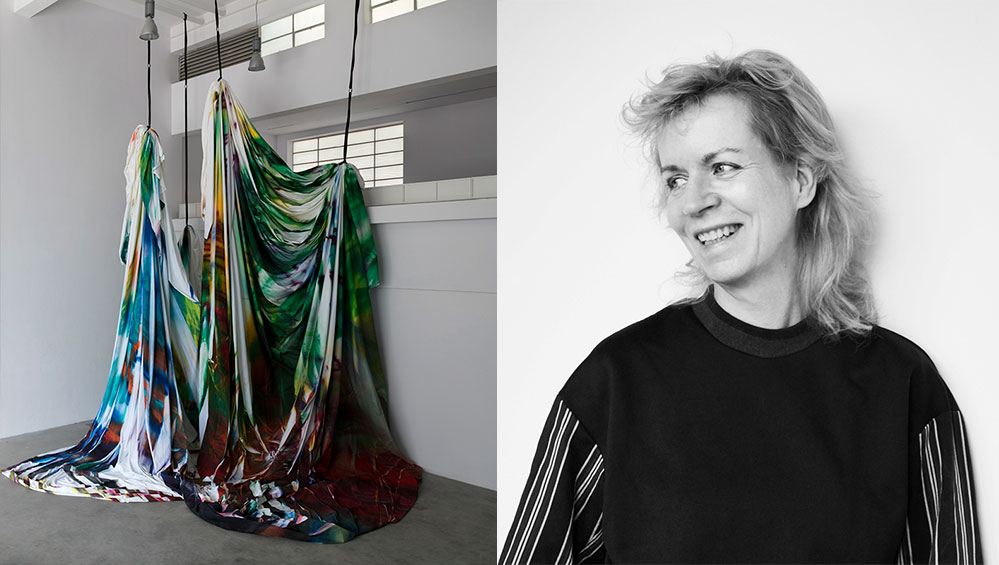
by ANNA McNAY
Katharina Grosse (b1961, Freiburg im Breisgau, Germany) is known for her large-scale, often site-specific and in-situ paintings, which draw the viewer in, disrupting and redefining hierarchies and boundaries, and shifting perspectives. For Grosse, there is no distinction between painting, sculpture and architecture. As well as her smaller studio canvases, she paints on found materials, cast-metal sculptures and lengths of draped fabric, creating fully immersive installations.
Currently showing as part of the all-women group exhibition Push the Limits, at the Fondazione Merz in Turin, Italy, Grosse talks to Studio International by email about her views on time, energy and meaning.
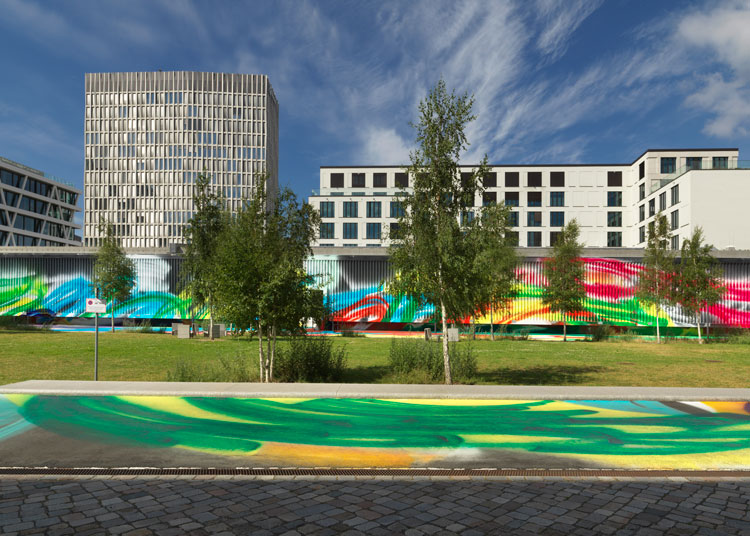
Katharina Grosse, It Wasn’t Us, 2020, Hamburger Bahnhof – Museum für Gegenwart – Berlin. Acrylic on floor, polystyrene and bronze; paint on asphalt, concrete, bricks and metal, 700 x 6,500 x 18,300 cm. Courtesy König Galerie / Gagosian / Galerie nächst St. Stephan Rosemarie Schwarzwälder. Photo: Jens Ziehe. © Katharina Grosse and VG Bild-Kunst, Bonn, 2020.
Anna McNay: You have spoken before about challenging yourself to make painting visceral and a visible part of our everyday life. In what ways do you set out to achieve this?
Katharina Grosse: We have so much imagery in our lives that comes from homogeneous surfaces – from the screen, from photography, from our phones. I think that tactile images, or multilayered images such as painting, provide a different kind of knowledge. I am searching for a painted picture that has bodily contact, that addresses the entire bodily intelligence and can resonate in every fibre of our being. I expand scale to such an extent that my paintings demand physical involvement and movement on the part of the visitors. Site, viewer and work of art become entangled in a relationship of mutual dependency and create an ecosystem. There is no longer a threshold indicating where one starts and the other stops.
AMc: Do you see your works as aesthetic, expressive, energetic, or emotional? Or all of the those things?
KG: All of them are integral to my work, except for being expressive. I do not feel there is something within me that is being expressed or externalised that is not already “outside”. I do not see a separation between inside and outside to begin with.
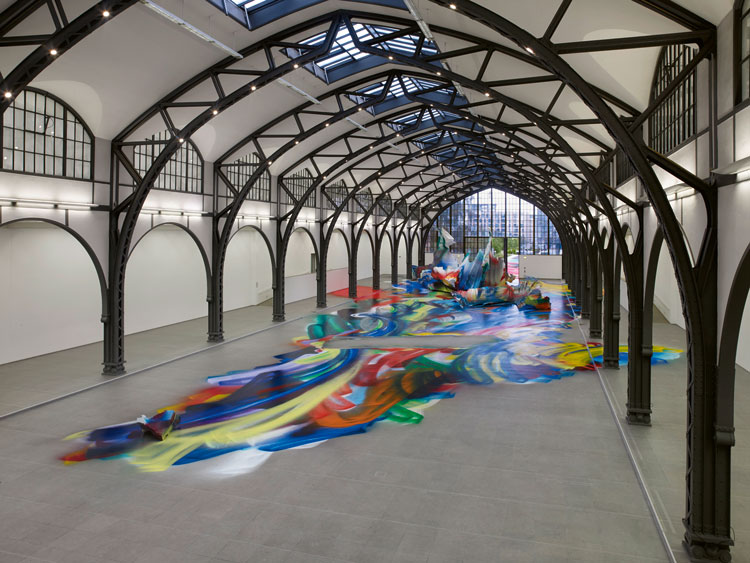
Katharina Grosse, It Wasn’t Us, 2020, Hamburger Bahnhof – Museum für Gegenwart – Berlin. Acrylic on floor, polystyrene and bronze; paint on asphalt, concrete, bricks and metal, 700 x 6,500 x 18,300 cm. Courtesy König Galerie / Gagosian / Galerie nächst St. Stephan Rosemarie Schwarzwälder. Photo: Nic Tenwiggenhorn. © Katharina Grosse and VG Bild-Kunst, Bonn, 2020.
AMc: Another thing you have spoken about before is the lack of linear structure within painting. Does this absence give you a sense of freedom, or do you try to create and impose your own structure – even if only to then break that rule – in order to aid your composition?
KG: Painting allows for a unique understanding of time. Unlike any other medium, it allows us to see different moments in time within one and the same painting. All the layers on the surface generate a cluster of time. A painting reverses your understanding of present, future and past to a point that it even annihilates it.
AMc: While the structure may not be linear, as you have just mentioned, you build up myriad layers of paint in many of your works – like a palimpsest. Is this a form of structure that carries meaning in its own way?
KG: Because the painted picture is multilayered, it is very tactile. As a time-cluster, it stimulates the entire bodily intelligence; it creates an experience of intertwined energy. Physical intelligence is everything. I believe that the haptic picture summons up empathy as no other picture with a homogeneous surface can. I seek to compress emotions and cause vehement agitation. I want us to be so disturbed, positively or negatively, that we develop the wish to change something. Preferably immediately and repeatedly.
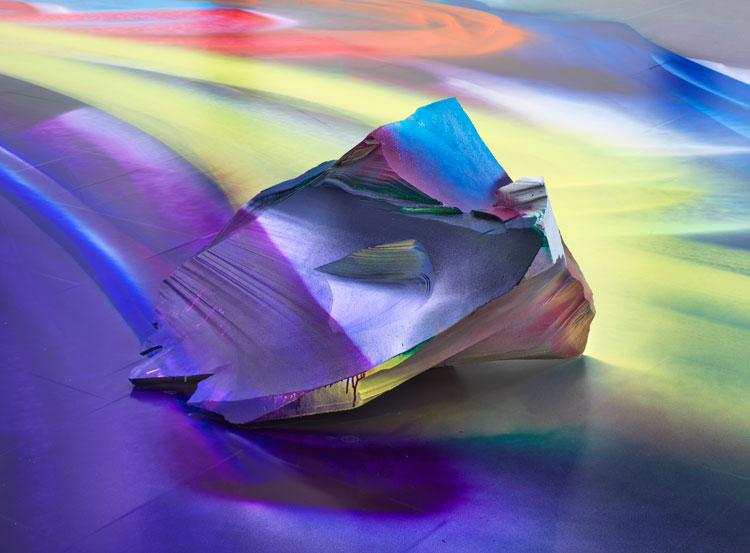
Katharina Grosse, It Wasn’t Us, 2020, Hamburger Bahnhof – Museum für Gegenwart – Berlin. Acrylic on floor, polystyrene and bronze; paint on asphalt, concrete, bricks and metal, 700 x 6,500 x 18,300 cm. Courtesy König Galerie / Gagosian / Galerie nächst St. Stephan Rosemarie Schwarzwälder. Photo: Jens Ziehe. © Katharina Grosse and VG Bild-Kunst, Bonn, 2020.
AMc: Colour is clearly fundamental to your work. How do you go about giving it form, or does it find it itself? Or is the form simply in the mode in which the colour exists – as pigment, as a fluid mixture, as spray paint, as a surface applied on top of another surface?
KG: The way I understand and use colour, it does not generate fixed meanings, and it does not serve specific functions or hierarchies. I want to infuse energy and transformation into a situation or space, so as to trigger alternatives to our habitual responses.
AMc: What do you mean when you speak of “the anarchic potential of colour”?
KG: Colour isn’t connected to specific surfaces or materials or to a particular place. A painting can land and remain anywhere: on a rubber boot, on an egg, in the crook of the arm, in the garden, on bulging folds of fabric, along a railway track, in the snow and ice, or on the beach. If painting isn’t connected to place, then the imagination is not connected to place; and since imagination is immediate reality, reality as well is siteless. I want to show that it is always possible – not only for me, but for everyone – to also view and experience reality differently. Not only there where I show it. Everywhere. Always. Here. Now. Embracing uncertainty in such a way could influence how we look at gender, race, society and politics.
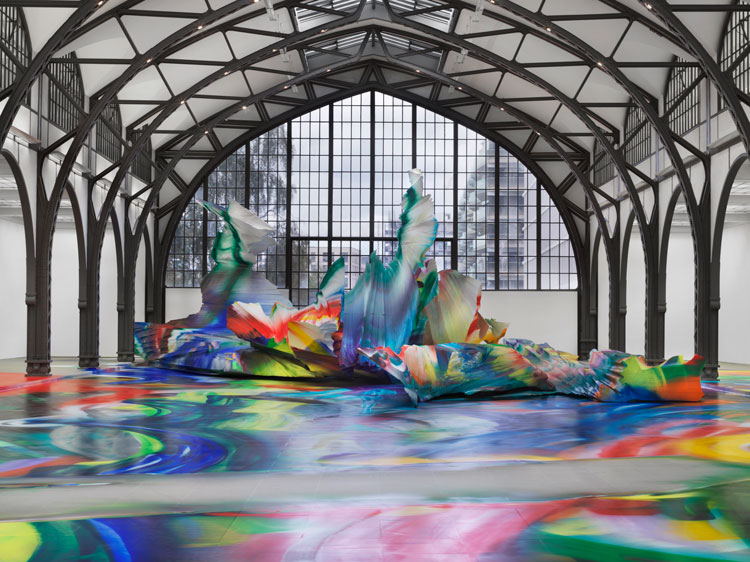
Katharina Grosse, It Wasn’t Us, 2020, Hamburger Bahnhof – Museum für Gegenwart – Berlin. Acrylic on floor, polystyrene and bronze; paint on asphalt, concrete, bricks and metal, 700 x 6,500 x 18,300 cm. Courtesy König Galerie / Gagosian / Galerie nächst St. Stephan Rosemarie Schwarzwälder. Photo: Jens Ziehe. © Katharina Grosse and VG Bild-Kunst, Bonn, 2020.
AMc: Tell me a bit about how you work with colour. Do you set out to create a new piece with a specific palette in mind? Do you mix colours as you go along, or is the only “mixing” achieved through layering?
KG: There are certain parameters, which are set before I start working, and the colour palette is one of those. I never mix my colours; mixing is achieved only through layering. I have maybe three yellows, three reds, three greens, three blues, a couple of in-betweens, mostly to shift between cold and warm, opaque and translucent and white, and some interference colours, but that’s all.
AMc: Is the painting process a purely instinctual process, or is there also rational and logical thought and planning involved?
KG: My assistants and I discuss and plan everything beforehand in detail with the help of different scale models. Many rational and pragmatic decisions are to be made. It can also happen that I intuitively try out new approaches in the middle of the project and discard elements that were important until then. Sometimes misunderstandings lead to better solutions than minutely developed plans. It also sometimes happens that, all of a sudden, a very clear picture of a previously unimagined possibility appears in my mind, that I then start to pursue.
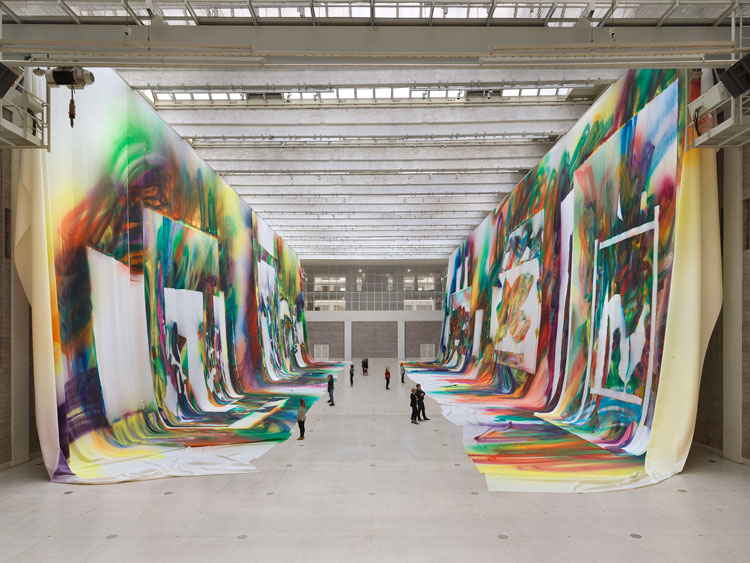
Katharina Grosse, Wunderbild, 2018. Acrylic on fabric, 1,450 x 5,620 x 670 cm and 1,450 x 5,490 x 690 cm. Installation view National Gallery in Prague, Czech Republic. Photo: Jens Ziehe; Commissioned by National Gallery in Prague; Courtesy Galerie nächst St. Stephan Rosemarie Schwarzwälder, Gagosian, and König Galerie. © 2020 Katharina Grosse and VG Bild-Kunst, Bonn.
Once the physical structures or supports have been installed on site, I join in and start the painting from scratch. The painting decisions are all made on site, according to how my intentions and emotions develop in relation to the given situation, to the multidimensionality of the setup, to the light, to conversations, or to new thoughts for future projects that often occur along the way. The work is not only the material apparition of its presence, but it is the sum of its influences.
AMc: Do different colours carry different meanings and connotations for you? Are these fixed, or do they change depending on context?
KG: If a lemon is painted blue, for instance, your whole experiences of lemons can change completely. I think colour is the most magical surface changer. The choice of colour is always related both to its context and the strategies I keep developing throughout the process, concerning the autonomy of the work and its “host”.
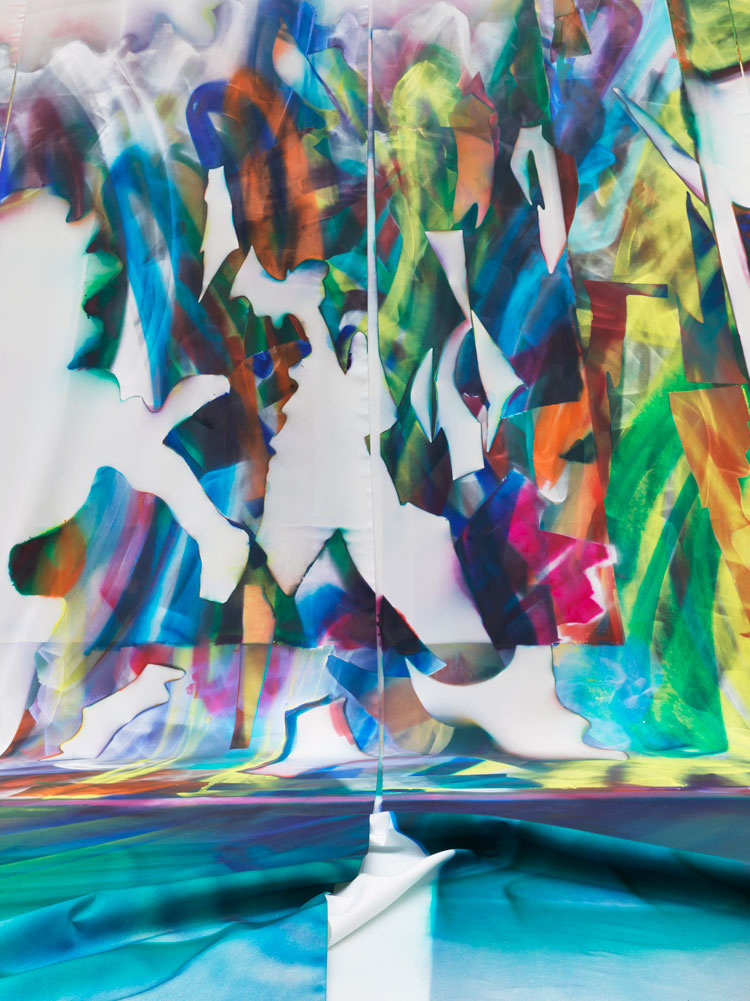
Katharina Grosse, Wunderbild, 2018 (detail). Acrylic on fabric, 1,450 x 5,620 x 670 cm and 1,450 x 5,490 x 690 cm. Installation view National Gallery in Prague, Czech Republic. Photo: Jens Ziehe; Commissioned by National Gallery in Prague; Courtesy Galerie nächst St. Stephan Rosemarie Schwarzwälder, Gagosian, and König Galerie. © 2020 Katharina Grosse and VG Bild-Kunst, Bonn.
AMc: Tell me a bit about the point at which you broke free from the constraints of the traditional canvas and use of the paintbrush. Do you always work with a spray gun these days? What other tools do you use?
KG: I came across the spray gun by chance. A friend of mine in Marseille made me use one. Somehow, the way the little sprayed dots sat on the surface stuck with me. The first piece sprayed directly on to architecture was the Green Corner in the Kunsthalle Bern (Untitled, 1998), curated by Roman Kurzmeyer, where I sprayed green acrylic paint directly into a corner, activating the space between two walls and the ceiling. I did that because my eyes got transfixed by that spot in the exhibition space. My eyes are my most important tools.
AMc: What inspires you in terms of new works, but also to get up and get on each day?
KG: One of my biggest inspiration is ball games – the anticipation of the other player’s movements, the bridging of distances, the shrinking and expanding of spaces.
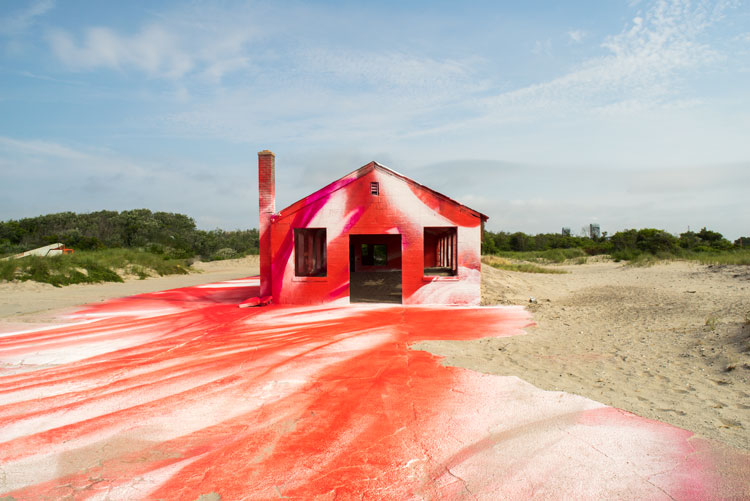
Katharina Grosse, Rockaway, 2016. MoMA PS1’s Rockaway! series, New York, USA. Acrylic on wall, ground and various objects, 600 x 1,500 x 3,500 cm. Photo: Pablo Enriquez; Courtesy of MoMA PS1. © 2020 Katharina Grosse and VG Bild-Kunst, Bonn.
AMc: What attracts you to working on such a large scale? And how does your approach differ in such instances from when you are working on paper or canvas?
KG: The intensity with which I do the site-specific pieces is always very strong, because I work, maybe, 10 days straight; there is nothing that interferes with my activity. With my studio works, it is very different. I work on many canvases at the same time, and I keep on coming back to them for weeks. The in-situ work allows me to expand the painting, to slow it down and magnify aspects of the movement. In my studio practice, I compress the space of activity. I overcharge the surface.
AMc: How important is the site-specificity of a work? How does the venue feed into its conception?
KG: There is a resistance that the site and the material put into my thoughts that is very productive. The wind, water, asphalt or light, as well as the people and parties involved, will affect my decisions. This constitutes a field, where all existing elements are on the same level and the process is open. The making of my work requires a radical acceptance for everything that emerges in the process.
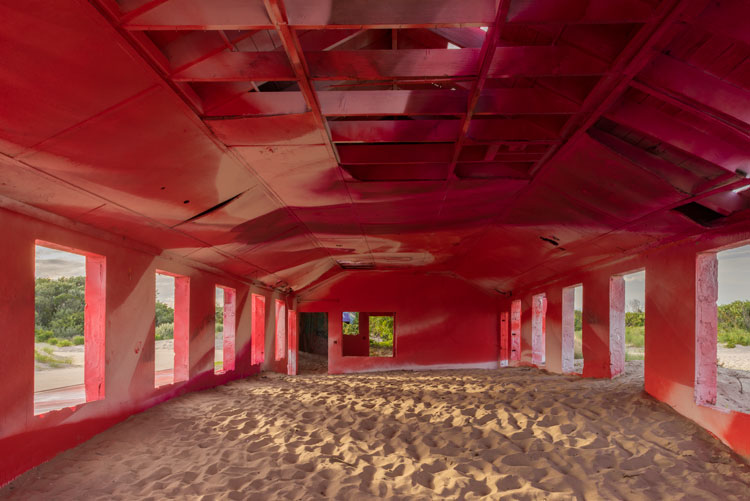
Katharina Grosse, Rockaway, 2016. MoMA PS1’s Rockaway! series, New York, USA. Acrylic on wall, ground and various objects, 600 x 1,500 x 3,500 cm. Photo: Pablo Enriquez; Courtesy of MoMA PS1. © 2020 Katharina Grosse and VG Bild-Kunst, Bonn.
AMc: How much do viewers bring to the work? They are not just passive bystanders, but effectively become a part of the space, which, to a degree, defines the boundaries of the work. Are they then a part of the work as well?
KG: Every ingredient shifts and redefines the hierarchies and boundaries, again and again. Nothing stays as it is.
AMc: Is working on multiple canvases at any given time a necessity for you? Do you wake up and know which specific work is calling you that day?
KG: I just come to the studio in the morning and start.
AMc: Do you consider yourself a painter, or do you prefer your work to be read as sculptural or performative?
KG: I actualise painting for the time I live in.
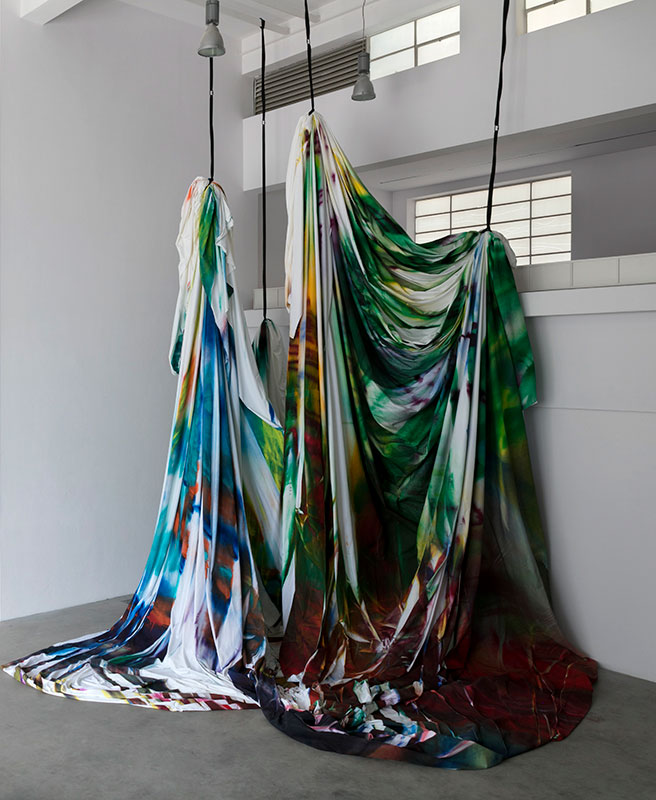
Katharina Grosse, The horse trotted a little bit further, 2020, acrylic on fabric, 5500 x 1500 cm. Exhibition view, Push the Limits, Fondazione Merz.
AMc: You are part of the all-women group exhibition, Push the Limits, at Fondazione Merz in Turin. Can you tell me a bit about The Horse Trotted a Little Bit Further (2020), the work included in this exhibition? What, for example, does the title reference or mean? Was it made specifically for the foundation?
KG: Yes, the work was conceived specifically for the exhibition at Fondazione Merz, but it was created out of three cloth tracks from the much larger installation The Horse Trotted Another Couple of Metres, Then It Stopped, which was shown at Carriageworks in Sydney in 2018. The cloth in Turin is hung in such a way as to form a new entrance to the exhibition. The title refers to a tale my father told me when I was a child: when Perceval fought the Black Knight, he was wounded and drops of blood dripped on to the snow. He started to drift off, to forget about the fight, longing for home and his beloved. Realising that something was wrong, his clever horse turned so that Perceval could see the crimson traces of his own blood in the white snow. That realisation shook him out of his daze and brought him back into the present. So, to trot another couple of metres is a great method of becoming aware, to effortlessly shift in order to perceive the world from another perspective.
• Push the Limits is at Fondazione Merz, Turin, Italy, until 31 January 2021.